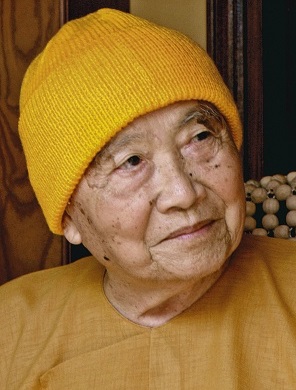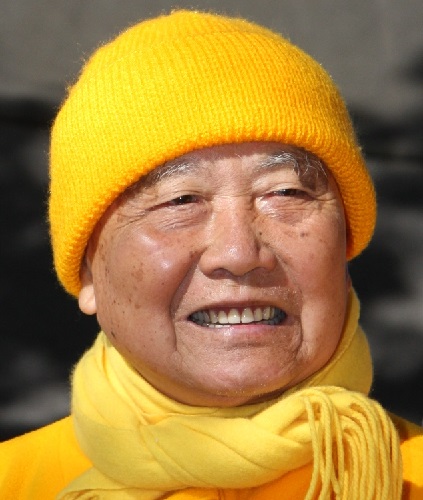ZEN MESTEREK ZEN MASTERS
« Zen főoldal
« vissza a Terebess Online nyitólapjára

Thich Thanh Tu (1924-)
[THÍCH* Thanh Từ 釋清慈]
*Thích (釋) is Vietnamese for Sakya, which is the Buddha's family name. Every monastic member in the Vietnamese Buddhist tradition has a name which begins with Thích.
Zen Master Thich Thanh Tu
Birthname : Tran Huu Phuoc
Birthday : July 24, 1924
Birthplace : Tich Khanh hamlet of Vinh Long province, Vietnam
He was borned and raised in a scholarly family, whose religion was Cao Dai (a popular religion in Vietnam). At young age, he had revealed some unique characteristics such as compassion, contemplation, poise, honesty, and reading interests. As time progressed, his compassion to beings and thought of renunciation grew stronger. Witnessing human's suffering during wartime, he was awakened and determined to become a monk. His goal was to find a way to help beings relieve their sufferings. At the age of 25, he was ordained by Master Thich Thien Hoa at Phat Quang temple after 3 months of Buddhist duties. His Buddhist name was given as "Thich Thanh Tu." Ten years passed by with much of effort in learning and practicing, he had completed his basic, intermediate, and high Buddhist education at known Buddhist schools in Vietnam. Later on, he started teaching at various locations, which include Van Hanh Buddhist school, Duoc Su Buddhist school, and Hue Nghiem Buddhist College. Over the years of teaching, he had held several important positions and published a few valuable books.
But his goal would not rest at that point. After 3 years of his servicing as an expression of gratitude to his Master, he decided to leave on his own to find his "true self" or his "unlearned knowledge." Knowing the "Pure Land" method would not help him to accomplish his goal, he decided to proceed meditation. This set of mind had opened a new chapter for " The Vietnamese Zen at late 20th century ." In 1966, he built Phap Lac meditation center and lived there to pursuit his practice. During this period of time, he continued his writings and translations. Two years later, he made a public announcement that he would practice in seclusion indefinitely. He goal was "if I don't thoroughly discern the Way, I won't leave the meditation chamber." He had tried different methods such as contemplations of "Six Marvelous Methods," "Impurity," and even the riddles, etc. But these gave no results. Though, the failure would never make him quit. At last, his determination made a harvest as he discerned the concept of "Nothingness." He then reviewed the Mahayana suttras that discussed about Nothingness and was able to understand them all. By remembering the phrase "after realization, enlighten others," he decided to expose himself to the public to perform Buddhist teachings and other meaningful tasks.
In December of 1971, the first study program started with 10 students. His principle of teaching is "learning and practicing concurrently." The reason is he needs to make sure that our understanding and practicing follow what said in the suttras. This helps practitioners to evade mistakes that could lead to ailments. His lectures were on the Buddhist scriptures, discourses, and history as well as the basic meditation methods. The focus is "aware the false thoughts, but not attach to them." Three years later, he opened the second program at 3 locations: Linh Quang monastery, Chan Khong monastery, and Bat Nha monastery. Upto now, he has made many significant accomplishments through various forms: Writing, translation, lecturing, establishing monasteries, and teaching over a thousand of monks and nuns. Currently, all monasteries (established by the Master) are learning and practicing the principle of Truc Lam sect. He always wants to implement what quintessential from Vietnamese Zen masters that has been forgotten for the past centuries.
Gradually, his dharma teachings have spread all over the world through his lecture tapes and writings. For several years, he has visited some foreign countries to give dharma lectures. Numbers of practitioners, scholars, and Buddhist laities have studied and practiced his Zen methods. His words are quite simple, but profound and excellent, that people from any background (from a blue color worker to a doctor) could understand. To make this "transmission of the light" propagate wider to different ethnicities, some of his books have been translated into English. Also, the Vietnamese Buddhist Meditation Congregation has established in 2001 and its headquarter is at Dai Dang monastery in California.
Looking back to his past, we have to praise his intentions, achievements, and merits. He had done what no one had done which is the task of "Renovating Truc Lam Zen sect" of Vietnam. With much respect and gratitude, we all try to follow his footsteps to maintain the existence of Vietnamese Zen. Despite these facts, he is still humble as he said in the poem "The Wild Sunflowers ": He is just a wild sunflower a wild sunflower that ensconces aside the highways!
The Wild Sunflowers
(Translated by Tu Tam Hoang)Here are the wild sunflowers
Only grow along the forests
Ensconce aside the highways
Be the hedge to against ill-doers
Late Autumn, come the buds
Open bright in yellow
In spite of people's disdain
They exert to adorn the homeland
In joy, they're picked by the herdsmen
In need, they're the rats' hideout
They're the protector of all beings
Writings
| My Cherished Goal (from "My Whole Life") |
|
| The Basic Practicing Method For Buddhists (from "The Source of Buddhist Dharmas") |
|
| Practice In Any Circumstance (from "The Source of Buddhist Dharmas") |
|
| The Root of Superstitions (from "The Carefree Leaves") |
|
| Life Is Relative (from "The Carefree Leaves") |
|
| An Eternal Smile (from "The Carefree Leaves") |
|
| Zen Poetry Collection (from "If You Know") |
|
| Love Vanishes When People Need A Delicious Taste (from "The Carefree Leaves") |
|
| No Hardship Could Discourage Us (from "Buddhism and The Youths") |
|
| The Virtue of Perseverance (from "Buddhism and The Youths") |

Thiền sư Thích Thanh Từ
PDF: Self-regulation techniques in Vietnamese Zen Truc Lam monastery
by Joanna Różycka-Tran / Quan Anh Tran
Gdańskie Studia Azji Wschodniej, 2014/6, pp. 123-133.
PDF: Altered Space for a New Zen in Vietnam
by Alexander Soucy
Abstract: Twentieth century events, with the Buddhist Revival (in response to
colonialism), the war (and subsequent dispersal of the Vietnamese overseas), and
Communist challenges, have brought about a renewed interest in Zen Buddhism in the
twenty‐first century. The southern Vietnamese monk, Thích Thanh Từ, has drawn on
potent historical signifiers of Trần Nhân Tông and the only Vietnamese Zen lineage (Trúc
Lâm) to create a new kind of Zen while simultaneously claiming identity with a
nationalistic symbol from the past. In 1997 a local pagoda was taken over by Thích Thanh
Từ's organisation and Zen missionaries from southern Vietnam have turned it into a
major Zen centre on the outskirts of Hanoi. This paper will explore how they have created
and transformed the northern Buddhist space into something entirely new, reflecting
more Modernist/Western/Global visions of Buddhism than local Vietnamese Buddhist
understandings.